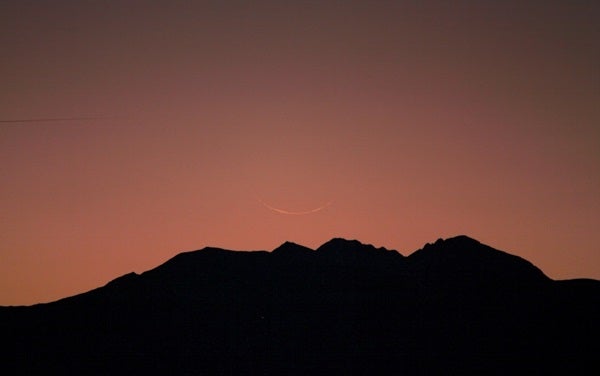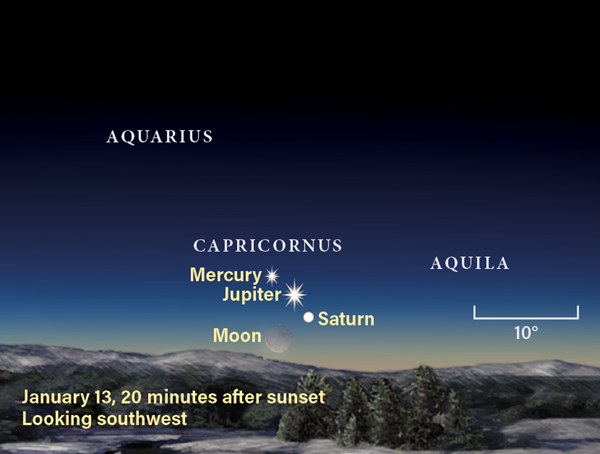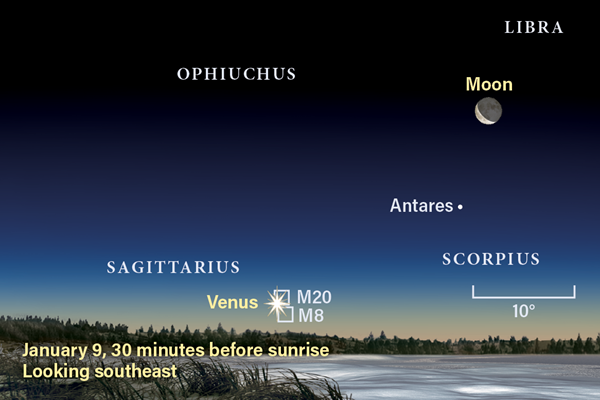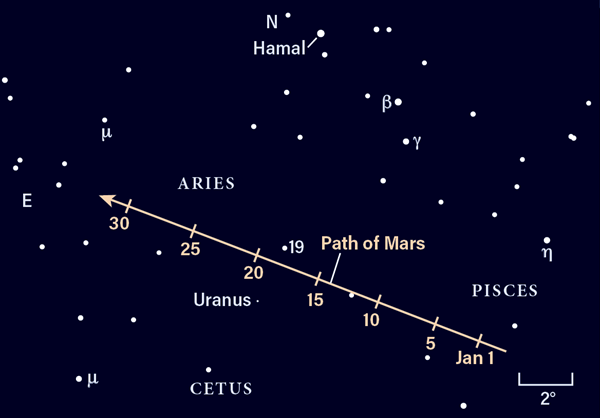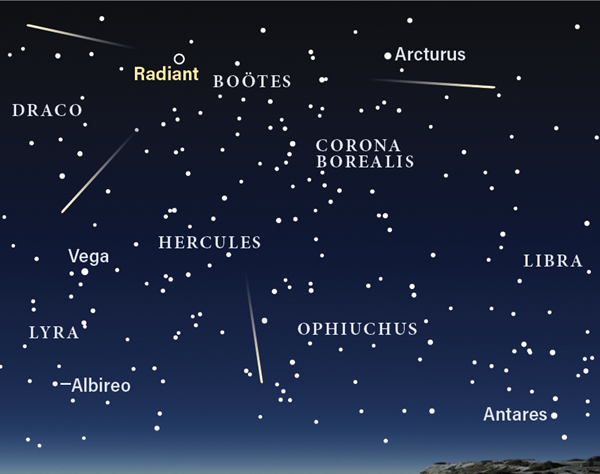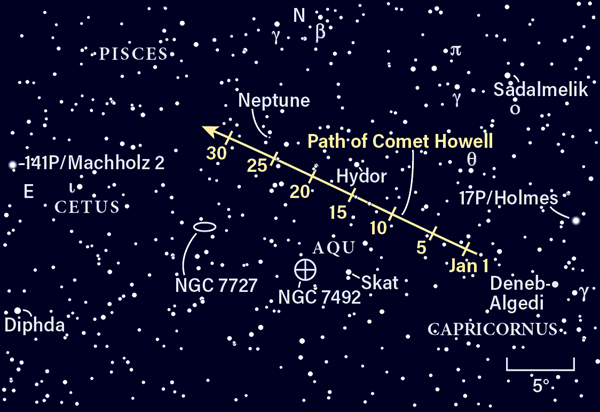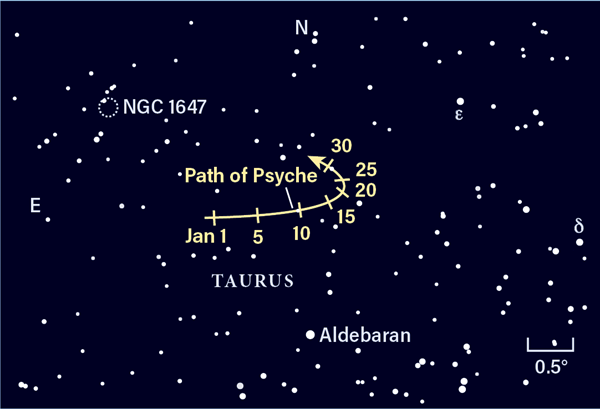During the first week of the new year, Jupiter and Saturn start out 1.3° apart and extend to 2° by January 7, when magnitude –0.9 Mercury joins the twilight scene 3.7° below magnitude 0.6 Saturn. Jupiter shines brightest at magnitude –2.
Mercury slides up to 1.9° due south of Saturn January 9, and the next evening forms a nice equilateral triangle with the gas giants. All three planets lie within a 2.3°-wide circle. On January 11, Mercury moves next to Jupiter and stands 1.4° to its south (lower right). Catch these events 30 minutes after sunset and for about the next 30 minutes before the last of the three planets sets around 6 P.M. local time.
There’s a challenging young Moon in this region January 13 — attempts to view it will require a very clear southwestern horizon. New Moon occurs at 12 A.M. EST on January 13, and that evening at sunset will show a less-than-1-percent-lit crescent. Search for it between 20 and 25 minutes after sunset, when our satellite stands about 1° above the horizon. It’s a very difficult observation unless conditions are perfect.
The Moon and Mercury form an elegant pairing on January 14, standing about 7° apart. Saturn is quickly lost in the sunset glow and heads for its January 23 conjunction with the Sun. Jupiter also slides away, now 4.6° to the lower right of Mercury (due west). Mercury continues to climb higher in the sky until January 23, when it reaches greatest eastern elongation — the second best of the year for Northern Hemisphere observers (there’s a better one in May). On the 23rd, Mercury sets an hour and a half after the Sun and is a bright magnitude –0.6.
Neptune is an easy binocular object for the first few hours of January evenings, shining at magnitude 7.8 in eastern Aquarius. On January 1, it is 1° east of Phi (ϕ) Aquarii, a 4th-magnitude star 21° due south of Markab in the Square of Pegasus.
A quick peek at Phi reveals a pair of 6th-magnitude stars forming a triangle with Phi 1.5° to its east and northeast (96 Aquarii). Neptune spends the first three weeks of the month within this triangle. From January 17 through the 23rd, Neptune’s eastward motion from night to night places it midway between these two 6th-magnitude stars, allowing easy identification in 7×50 binoculars. The planet sets by 11 P.M. local time January 1 and before 9 P.M. January 31, so catch it in the first couple of hours after sunset for the best views.
Mars still a great object to observe throughout January. Starting the month with an apparent size of 10″ and a magnitude of –0.3, it is best viewed with scopes larger than 8 inches. Smaller scopes can achieve good results using a planetary video camera and a quality barlow lens.
Mars starts the year within the faint line of stars representing one of the Fish in Pisces. The Red Planet crosses into Aries January 5 and makes its way across the sparse southern region of that constellation.
On the way, Mars passes apparently close to Uranus, a great time to spot that distant world. From the 18th to the 22nd, Mars and Uranus stand less than 2° apart. Uranus is exactly 1.7° due south of Mars January 21. Swing binoculars toward Mars and look for Uranus to its south, shining at magnitude 5.8. Don’t confuse Uranus with a star of the same magnitude, 19 Arietis, which stands on this night due west of the Red Planet. Through a telescope, Uranus offers a bluish-green hue, a wonderful contrast to Mars’ red glow.
Mars continues eastward across southern Aries through the remainder of January, fading to magnitude 0.4 as the apparent size of its disk shrinks to 8″. You can continue to observe Mars past midnight; it sets one to two hours later.
Through a telescope, the Red Planet exhibits a gibbous disk 89 percent lit. Features visible early evening (9 P.M. EST) during January range from the Tharsis ridge and desert regions early in the month, to Valles Marineris midmonth, to Sinus Sabaeus and Sinus Meridiani in the third week of the month. Syrtis Major and the Hellas basin are central on the disk during January’s last week.
Skipping back to Uranus, its general proximity to the red beacon of Mars this month makes this a perfect time to spy the distant planet, which sticks close to 19 Arietis even as Mars flies past. The ice giant’s disk spans 4″.
Venus rises more than an hour before the Sun on January 1, located 12° east of Antares. You’ll find it low in the southeast as twilight develops. Venus is currently moving along its orbit on the far side of the Sun and shows a 94-percent-lit disk, which grows to 98 percent lit by January 31. It shines at magnitude –3.9, making it readily visible in morning twilight.
On January 9, Venus stands 4° high 45 minutes before sunrise and is located between M20 and M8, the Trifid and Lagoon nebulae, respectively. The nebulae won’t be visible, but their embedded star clusters will, making for a fine view in binoculars.
Two days later, a delicate crescent Moon rises about 4° to the right of Venus on January 11. The pair closes in slightly as it rises. For another challenge, see if you can spot the bright globular cluster M22 (magnitude 5), located 46′ due south of Venus the morning of January 15.
Venus drops lower in the sky each morning and becomes lost soon after the end of the month, rising only 30 minutes before sunrise Earth reaches perihelion January 2, when we sit nearly 91.4 million miles from the Sun.
Rising Moon: The Maginus ray
There is a ray of hope (okay, sunshine) on the 21st, spreading across the floor of the large, battered crater Maginus. Rilles, domes, and scarps — like the Straight Wall prominently visible a few large craters to the north — all depend on their height to cast shadows onto the surrounding plains. In complete contrast, Maginus sports a bulged-up floor, central peaks, and, most crucially, a severely dented rim that allows a prominent V-shaped splay of sunlight to thrust out across the darkness.
Don’t confuse this use of the word ray with the much more common ejecta rays seen at Full Moon. The latter are the result of large impacts spreading lighter-hued material across the face of the Moon in long lines, the most spectacular of which is from nearby Tycho.
Like so much in astronomy, timing is everything. One evening earlier, Maginus is in complete darkness; one later, the Sun has risen high enough to illuminate almost all of the crater. Maginus will also appear much closer to the limb than on our map. Luna is below the ecliptic, so we are slightly looking down on it instead of being face-on. This tilting is called libration.
One week later, we reach Full phase. At that time, the Sun will be high overhead in the lunar sky, the previously visible shadows have disappeared, and all that remains of Maginus are subtle traces to be followed by the patient selenophile.
Meteor Watch: Shower by moonlight
The Quadrantid meteor shower is affected by moonlight this year. It’s active between December 28 and January 12, peaking on January 3 around 9:30 A.M. EST, making that morning the best time for North American observers. Unfortunately, a bright gibbous Moon is also in the sky starting around 10 P.M. on January 2, affecting the visibility of most meteors except the brightest.
The radiant lies in Boötes and rises after midnight, and expected observable rates increase as dawn approaches. Such a strong shower should still put on an occasional show worth viewing for those willing to weather the cold temperatures of a winter’s night under the stars. The Quadrantid meteors are associated with periodic comet 96P/Machholz and the minor planet 2003 EH1.
Comet Search: Fading slowly
For months after opposition, Comet 88P/Howell runs eastward against the stars. But Earth’s relentless faster pace leaves it slowly fading in the distance, sinking toward the Sun. Sliding through Aquarius toward Neptune, Howell is an early evening object this month. You’ll want to start looking for it 90 minutes after sunset. A 6-inch scope under dark skies will just catch its feeble 11th- to 12th-magnitude glow. Unfortunately, the Moon will be nearly Full when Howell drifts past Neptune at month’s end.Two faint comets could burst onto the scene and outshine Howell this month.
Comet 141P/Machholz 2 fragmented in 1999, but pieces keep returning and flaring up unpredictably to brighter than 10th magnitude. It travels from near Neptune across to Mira (Omicron [ο] Ceti). Comet 17P/Holmes jumped to 2nd magnitude back in 2007. It’s currently sliding a few degrees west and north of Howell. Observers near or south of the equator may find Comet C/2019 N1 (ATLAS) just outglowing the rest as it slides south past Alpha Centauri.
Locating Asteroids: Chilling with the Bull
A good sky location can be preferable to brightness. Main-belt object 16 Psyche spends the whole month a mere 1.5° north of Aldebaran, the ruddy eye of the celestial bull.
From the suburbs, a 6-inch scope will readily pick up the 10th-magnitude dot. A 4-incher will do nicely under darker skies or for a patient city observer using high power. Thanks to the “partly cloudy” dust lanes in Taurus, Psyche won’t be lost amid the populated Perseus spiral arm crossing the background. To positively identify it, make a sketch of the field and come back later to confirm which speck of light has shifted. Psyche slides only 6′ in 24 hours, so there’s little chance of catching its motion during a single observing session.
When Annibale de Gasparis discovered Psyche more than 50 years after 1 Ceres, it was only the 16th object found orbiting between Mars and Jupiter. Named after the Greek word for soul, Psyche is the target of an upcoming space mission to investigate its strange metal-rich composition.

